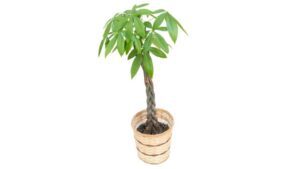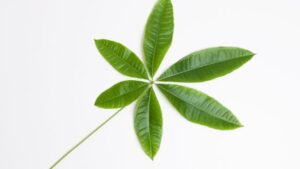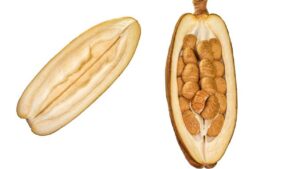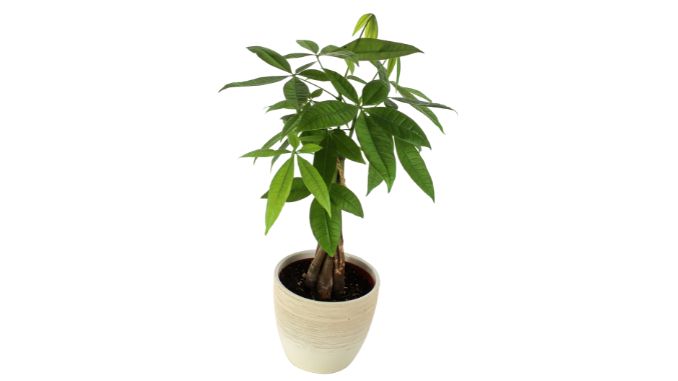Introduction
The money tree scientifically known as Pachira aquatica belongs to the Bombacaceae family. The common name of this plant is Malabar chestnut, Brazil nut, brown nut lucky tree, and Guinea peanut (1). This plant is native to Brazil but is nowadays found all over the world and is also very high in demand because of its feng shui movement as the Chinese believe that this plant brings good luck.
The plant is tropical and subtropical in origin. But is frequently found in marshy lands and riparian forests, however, it easily adapts to diverse soils and climatic conditions (1).
Uses of Money tree
- The plant is widely used for its edible seeds. the seeds are not only tasty but also highly valued for their medicinal properties, fibers, dyestuff, wood, etc. (2 & 3).
- The seeds of this plant are very yummy in taste. Roast seeds are tastes like peanuts and also used to make hot drinks.
- The young leaves and flowers of the money tree plants are also edible.
- The total protein content of the seed is about 16% and the fat is 40% with 25% carbohydrates (1).
- Medicinal uses of these plants are the bark is used to treat stomach problems and headaches and also purify the blood (4 & 5).
Money tree: As an ornamental plant

The plant is sold in the market with a braided trunk with less than 10 green leaflets as a bonsai plant. the plant can withstand excessively damp soil and bright sun and that makes the plant one of the most demanding plants in today’s market. In addition to this, the braided-looking trunk also adds extra ornamental value to this plant.
Botanical description of Money tree plant
The plant may become 15-18 m tall if they are growing in the natural environment. But can be kept up to 3 m in the home. Just to give the shape of a bonsai plant keep on prunning the new stems. Just trim the top of the plant.
1. Crown
The crown of the money plant is rounded and bushy in mature trees, with whorled branching (especially when young).
2. Leaves

Leaves are palmate, with 5-11 leaflets.
3. Flower

The flower buds are solitary, cylindrical, and erect, with linear creamy-yellow petals (20 – 30cm long) that peel back to reveal showy powderpuff flowers with pink-tipped white to yellowish-orange stamens.
4. Fruits

They are large egg-shaped woody capsules (30cm by 13cm wide), maturing to brown and splitting to disperse edible seeds that resemble Castanea sativa (Sweet Chestnut) or peanuts in flavor (7).
Money tree plant: How to take care
Light
medium to bright light is preferable for this plant. If the leaves of these plants started becoming yellow then keep them in sunlight but still avoid strong light.
water
As the plants grow in damp soil thus it needs constant water. do not let the soil dry and keep the soil evenly moist. But keep in mind the potting system should have a good drainage system. During the winter time avoid too much watering. As it needs humidity hence mist the trunk and leaves throughout the year.
Propagation
the propagation is via generative or vegetative. Seeds are the main mode of reproduction of this plant. For plants growing from the seeds, a good planting medium is used with a 1:1 mixture of soil and manure.
Vegetative propagation is mainly via stem cutting, about 20-30 cm stems are used for the propagation (6).
Soil
The water-holding capacity of the soil should be more than that of normal soil. As the plants are wetland plants and hence need more moisture in the soil.
Composition of seeds
the seeds of the money plants are rich in lipids, proteins, carbohydrates, calcium, magnesium, and potassium. Also are rich in secondary metabolites like tocopherol (a natural antioxidant), Phenolics compounds, and threonine and tryptophan amino acids which are categorized under essential amino acids (8).
Medicinal benefits of Money tree plant
1. Antioxidant activity
The seeds of this plant is having a high concentration of phenols and other compounds like tocopherols which shows high antioxidant activity. It has considerable potential to be used to prevent degenerative diseases due to its rich antioxidants (9).
2. Anti-inflammatory activity
The stems of the plant are used for the treatment and prevention of inflammatory diseases. Studies suggested that the stem extract of this plant and its isolated compounds exhibited great inhibition of superoxide anion generation (10).
3. Antimicrobial activity
The bark of the plant Pachira aquatica is having a compound named isohemigossypolone this compound is having antifungal effects against Pythium ultimum, Cladosporium herbarum, and Saccharomyces cerevisiae (11).
The leaf oil of this plant possesses antibacterial activity and is effective against Mycobacterium tuberculosis and Helicobacter pylori diseases-causing bacteria (12).
Precautions
1. Insecticidal activity of seeds
The seeds of this plant possess insectid]cidal activity on adult bugs. The extract of the seeds also showed repellent action against bugs, preventing them from getting close to coffee fruits (13).
2. Antinutrients property of the seeds
Although the seeds are great in taste eating raw seeds is not recommended. As it contains trypsin inhibitor (2.60 g/Kg flour). Studies done on animal model shows the lethal effect of these compounds with loss of appetite, weight loss, enlarged stomach, liver, and kidney, and ultimately death. Hence precautions should be taken before consuming the seeds. And it will be better not to consume raw seeds (14 & 15).
